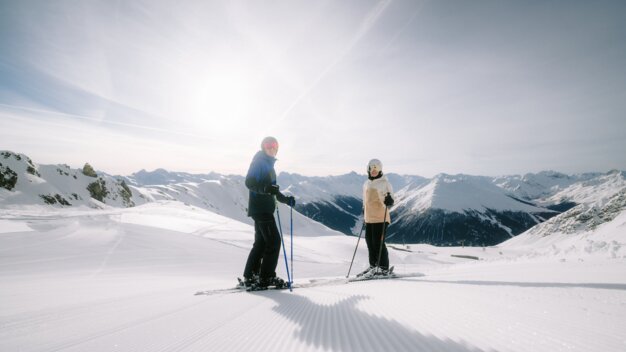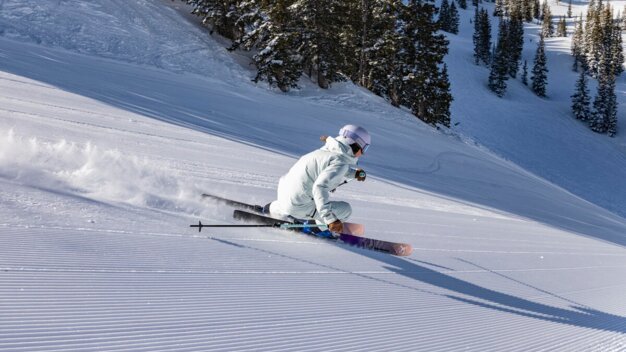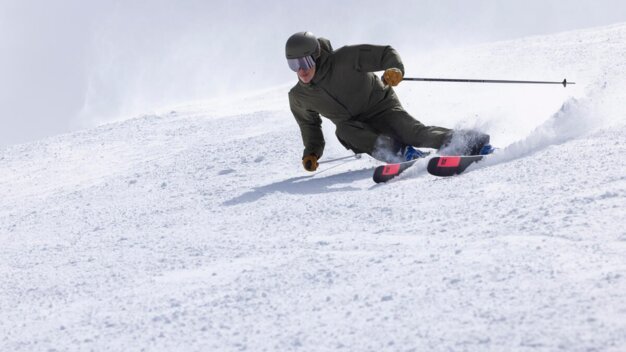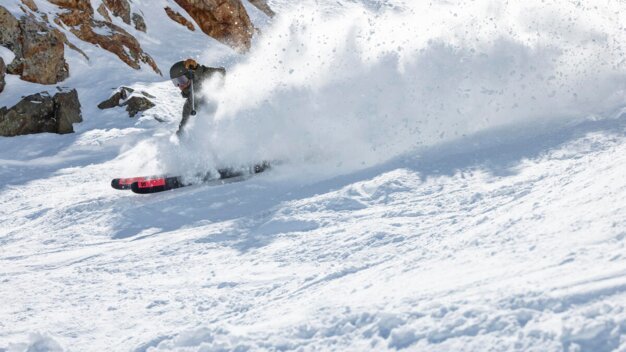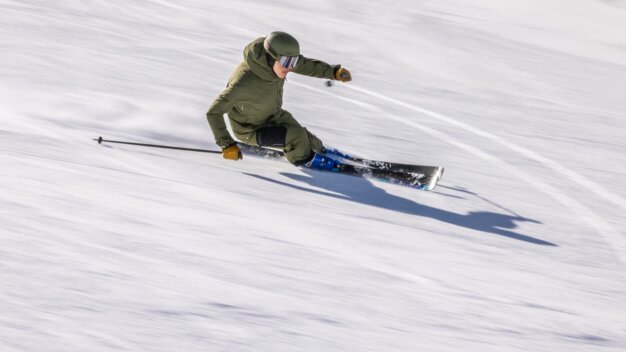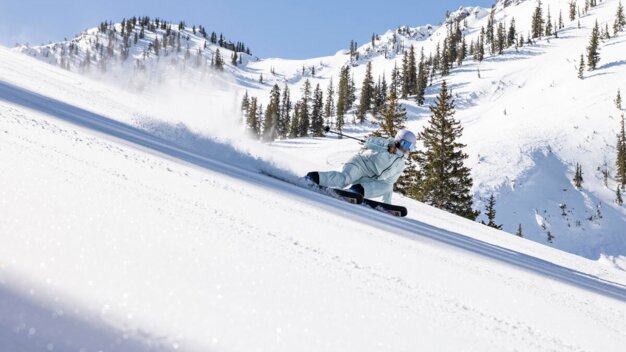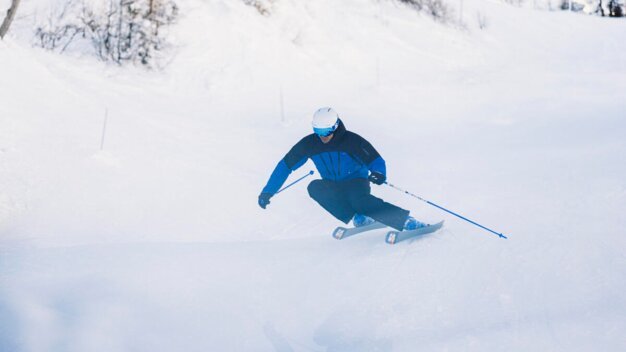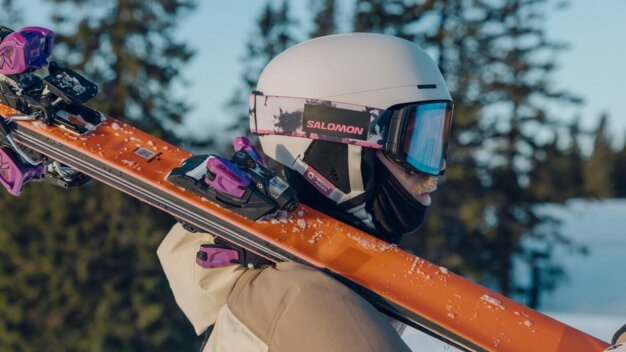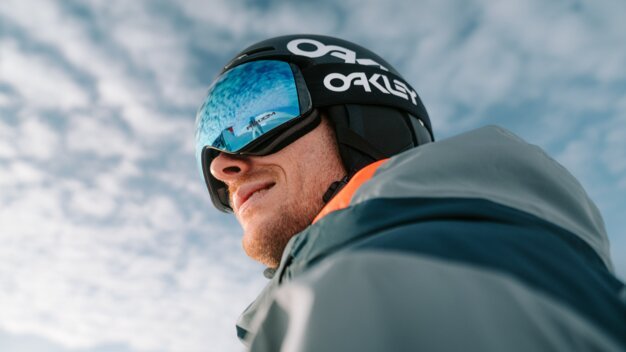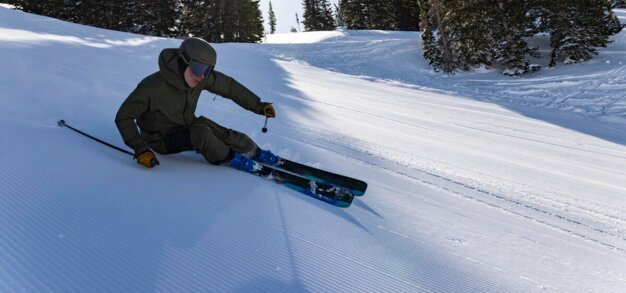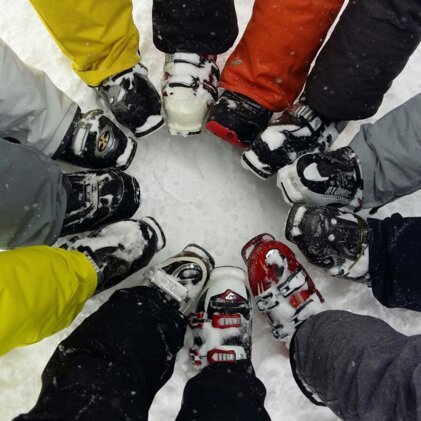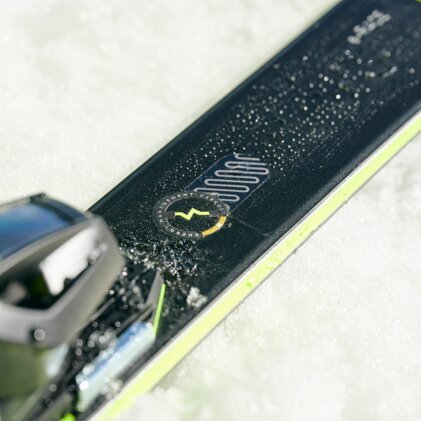
If you want to buy a new ski today, you can't go wrong with a carving ski. And for good reason! Thanks to its waist and rather short length, a carving ski is the perfect choice for turning. With the right technique, you can carve down the slope in style - turn after turn. And the pleasure increases with each run.
What is a carving ski?
A carving ski is the modern evolution of the classic alpine ski and has revolutionised the way we ski since the 1990s. The characteristic feature of these skis is their pronounced waist – the skis are significantly narrower in the centre than at the tip and tail. This special construction allows skiers to make elegant, sharp turns without exerting too much effort.
Originally developed for racing, carving skis have now found their way into all levels - from beginners to professionals. Thanks to their versatility, there are now different models such as slalom carvers, allround carvers and race carvers, which suit to different skiing styles and types of terrain.
Comparison of carving ski types: From all-mountain to racing
So which carving ski is the right one for you? That depends first and foremost on your carving technique – your preferred skiing style. Do you prefer to ski comfortably on freshly groomed blue and red slopes? Or do you prefer to ski off-piste, down steep slopes, in fresh deep snow? We have summarised some information which help you decide which ski is your perfect match.
Easy Carver: The carving ski for beginners
Easy carvers are the best choice for skier who want to take their first turns on the slopes. They are very manoeuvrable and easy to control when making mistakes. Easy carvers are the allround carvers for beginners, so to speak. They make it particularly easy for inexperienced skiers to keep control of their skis. Rapid progress and an entertaining performance in the snow is pre-programmed.
Ideal for: Beginners
Allround carving ski: Versatile for smooth turns
Allround carvers allows advanced skiers to keep their tracks stable at a medium speed. But beginners can also expect a safe experience. Allrounders tends to be shorter and is characterised by high agility and manoeuvrability. This agile allrounder ski makes a turn with little effort, ensuring a relaxed feeling.
Ideal for: Leisure skiers, beginners and advanced skiers
All-mountain skis: The ski for more variety
For an experienced skier who wants to have fun both on and off the slopes all-mountain skis are the perfect choice. This is a versatile ski that can cope perfectly with changing terrain. As an allround talent, it combines the advantages of high-speed race carvers and freeride carvers with an affinity for deep snow. For fast descents – for sure! Powder adventures – made easy!
Ideal for: Intermediate to advanced skiers on and off-piste.
Freeride skis: For deep snow and powder adventures
Are you a deep snow specialist? Then freeride skis are for you. These off-piste skis are at least ten centimetres wide and quite long. This gives you plenty of flotation and prevents you from sinking into the powder. Freeride skis also have a very low waist. You will have less fun on grippy slopes. There are two main types:
- Big mountain skis: Made for fast and long descents, smooth running, require strength in the thighs
- Backcountry freeriders: Manoeuvrable and agile, perfect for your off-piste performance
Ideal for: Experienced freeriders with a passion for deep-snow adventures
Race Carver: High speed with style
Your motto is "the faster, the better"? Then race carvers are probably the best skis for you. They are made for the groomed slopes and are very smooth. With their long, low-waisted design, they are reminiscent of classic giant slalom skis. With a wide turn radius, high torsional stiffness and hard flex, they provide an incomparable feeling when you carve over a beautiful, hard slope at high speed in wide arcs on the grippy edge of your race ski.
If you have good body awareness, plenty of strength in your legs and a good level of fitness, you will have a clear advantage.
Ideal for: Good skiers who like to ski on sporty slopes and at high speed.
Sport carvers – The allrounder among carving skis
Sport carvers (also known as crossovers or performance skis) are a flexible mix of slalom carvers, race carvers and all-mountain skis. Sport carvers promise a high level of comfort and effortless turn initiation. Sometimes lightning fast, sometimes extra twisty, sometimes a short detour into deep snow: these carving skis are particularly suited to sporty and experienced persons who like variety on the slopes.
Ideal for: Advanced skiers who like to switch between different styles.
Slalom carvers: Fast and agile in short radii
Mastering small and medium curve radii (ten to twelve metres) is a real pleasure with slalom carvers. The skis are stiff, short - about shoulder length - and high waisted. This allows quick edge changes and fast, short turns, even on steep slopes. Physical fitness is a prerequisite for keeping control of slalom models even on high-speed descents.
Ideal for: Athletic, well-trained skiers who love short, fast turns.
Freestyle skis: The right choice for cool tricks
Freestyle skis make you the star of the snowpark. The ideal freestyle ski is long, wide, durable, light and easy to turn, making it perfect for cool tricks. With the twin tip – both ends of the ski are slightly bent upwards – you can ski both forwards and backwards.
There are also different riding styles in the park that you should consider when choosing and setting up your new freestyle skis. Jib skis, for example, are lighter and shorter, while you need skis with more stability and smoothness for high jumps
Going fast down the slope? You don't want to do that on a freestyle ski!
Ideal for: Freestyle and park riders
Flex and torsional stiffness of carving skis
Flex or bending stiffness determines the degree of hardness of a ski (in the longitudinal direction). A high value means
- The ski is harder and you need better skills.
- A hard ski gives you a smoother ride.
A soft flex, on the other hand, offers you:
- The ski is more forgiving of mistakes.
- A soft flex ensures better manoeuvrability in turns.
Torsional stiffness also affects the strength of a ski. It determines how well the edges stay on the slope when pressure is applied.
- High torsional stiffness: The ski responds more directly and faster. Your ability should therefore be correspondingly good.
- Low torsional stiffness: A soft ski with low torsional stiffness, on the other hand, grips less well on ice and hard slopes, but is more forgiving of mistakes the skier makes.
Tip: The ideal ski hardness depends, among other things, on the athlete's body weight.
The right carving ski length and more
What do the length, width, waist and radius of a ski mean? We reveal what matters when it comes to size and shape!
The optimum carving ski length
The optimal length of a carving ski depends on your height, weight and style, but is functionally related:
Short skis (about 5 to 10 cm shorter than your height)
- easy to carve, ideal for small turns
- recommended for beginners
- better power transmission and less effort required
- easy to turn
Long skis (about 5 to 10 cm longer than your height)
- stable and smooth running at high speeds
- easier to control with more weight
- ideal for large turn radii
- requires technical skills
How to calculate your ideal ski length
The ideal ski width for carvers
The optimum width is defined by the type of ski. It is directly related to the waist and the radius of the turn:
Ski waist (centre width)
The waist of a ski is the difference in width between the tip (front), the waist centre (under the binding) and the tail of the ski. This characteristic shape significantly determines the skiing behaviour
- If a ski has a high waist, it is easier to carve small radii. Ideal for dynamic, sporty skier.
- A narrow waist is more suitable for long turns with pronounced radii and provides more control on hard slopes.
Turn radius for your carving ski
The turn radius is a key factor if you want to choose new skis. It indicates the radius that a ski can turn when a given amount of force is applied to the edge.
- Small radius: Short turns up to 14 m – e.g. slalom carvers and freestyle skis
- Medium radius: Turns between 14 and 18 m – e.g. all-mountain skis and allround carving skis
- Large radius: Long turns over 18 m – e.g. race carvers and freeride skis
The perfect carving ski for men and women
The difference between women's and men's carving skis goes far beyond different colours and designs.
Women's skis are designed specifically for the female anatomy and lower average body weight. They have a softer flex and a lighter construction. The position of the binding is also adjusted on women's models to accommodate the typically lower centre of gravity.
Men’s carving skis, on the other hand, have a stiffer construction and offer more stability at high speeds thanks to their heavier weight. They are particularly suitable for powerful, dynamic skiing and absorb bumps more effectively.
However, your choice should not be based on gender alone - individual factors such as height, weight, riding style and personal preferences are much more important for a good performance.
Whether you're looking for a carving ski for men, a carving ski for women, an allround carver, a slalom carver or a sports carver - choosing the right ski depends on your skiing ability and your preferences. With the right skis, you can have the most fun on the slopes!
Rent and test your carving skis
If you are not sure which carving ski suits you best, take the opportunity to try out different models at INTERSPORT Rent. You can test them in real conditions and find out which ski suits your skiing style best.
Frequently asked questions about carving skis:
Are carving skis suitable for beginners?
Yes, carving skis are great for beginners! Thanks to their special waist, they make it much easier to learn the right skiing technique. Beginner models in particular offer:
- More stability thanks to the wide ski shape
- Easier turn initiation thanks to the pronounced waist
- Forgiving construction with softer flex
- Better control even at low speed
Ask at INTERSPORT Rent for a carving ski that is specially designed for your needs.
How do you ski with carving skis?
The carving technique is fundamentally different from classic skiing. The skier first adopts a stable basic position with the legs hip-width apart and parallel and the knees slightly bent. The turn is initiated by shifting the weight of the body to the skis, while the upper body is calmly pointing in the direction of travel. Thanks to the special shape of the carving skis, the turn is then automatically guided by the geometry of the skis. For beginners, it is advisable to start with slow, wide turns and only increase the speed as you become more confident.
Which carving ski is right for me?
Choosing the ideal carving ski depends on a number of individual factors. Skiing ability plays a central role when you want new skis. Your intended area of use will also determine your choice - from classic slope skis to versatile all-mountain models to sporty race carvers. Personal factors such as body weight, height, preferred style and fitness level must also need to be considered to ensure an enjoyable performance on the slopes.
INTERSPORT Rent tip
Have you tested the latest carving ski models at one of the INTERSPORT Rent shops and are impressed by your test ski? Great, then take your new skis home with you - the "Test & Buy" promotion* makes it possible! Best of all, if you decide to buy, you will receive a refund of the rental fee for up to two days. Just ask our local RENTertainers!
*This option is currently only available in the shops in Austria.
Find your nearest INTERSPORT Rent Shop!
Related articles
You may also be interested in:
